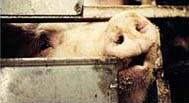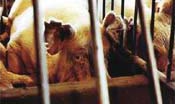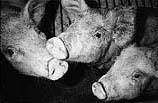
Inside The Pork Industry
Industrial pig farms now dominate the pork industry -- enabled by drugs that allow animals to be intensively confined, and encouraged by federal tax breaks that favor large-scale corporate agriculture. This has created dire consequences for consumers, the environment, and, of course, the animals.
Here a Crate, There a Crate
Factory farming has long been associated with veal production. But there is another animal who suffers confinement similar to that of the veal calf – the breeding sow. And in her case, the agony is prolonged for years.
 After impregnation, the sow is locked in a narrow metal gestation crate. The width of the crate varies from 18 to 24 inches, and the length is 7 feet, extending just beyond the sow's own body. She is restrained in this unbedded crate, standing on concrete-slatted flooring, for her entire pregnancy - nearly four months. She is unable to walk or turn around.
After impregnation, the sow is locked in a narrow metal gestation crate. The width of the crate varies from 18 to 24 inches, and the length is 7 feet, extending just beyond the sow's own body. She is restrained in this unbedded crate, standing on concrete-slatted flooring, for her entire pregnancy - nearly four months. She is unable to walk or turn around.
She is fed at one end of the crate, while her feces collects at the other. Some crates are so narrow that simply standing up and lying down require strenuous effort. Deprived of all exercise and any opportunity to fulfill her behavioral needs, she lives in a constant state of distress.
A common response shown by animals in highly-stressful situations where they have little control over their environment is to perform repetitive movements, called stereotypies. In frustration, a sow will repeatedly rub her snout back and forth across the front of the crate. Still others will frantically and repeatedly bite the metal bars of their crate.
Scientists studying these behaviors found they stimulate the release of endorphins in the sow's brain. This “self-narcotization” may provide a temporary measure of relief from the torment of crate confinement. Or these abnormal behaviors may be simply the desperate expression of frustrated animals pushed to the point of madness.
Piglets, Pain, and Profits,
A pregnant sow in a natural environment will isolate herself from the herd one or two days before delivering her piglets. She will seek a site where she will bring materials to build a nest. Even when raised in the shelter of a barn, domestic sows who are given straw and room to move will put together a nest for their piglets. The mother and her piglets form strong bonds. She will wait several days before leading her young out to meet and integrate with the rest of the herd.
 Confinement severely frustrates the natural behaviors involved in nest seeking, nest building, and the rearing of piglets. Except for the few days when she is being bred, the sow on a factory farm is constantly locked in a crate.
Confinement severely frustrates the natural behaviors involved in nest seeking, nest building, and the rearing of piglets. Except for the few days when she is being bred, the sow on a factory farm is constantly locked in a crate.
Near the end of her pregnancy, the sow is moved from the gestation crate to yet another restraining device, the farrowing crate. Against all her natural instincts, she must give birth to piglets, nurse them, eat, sleep, defecate, drink, stand, and lie in the same cramped space.
The nursing period is cut drastically short by the premature separation of the piglets from their mother. The sow is immediately re-impregnated - and sent back to an even bleaker existence in the gestation crate. This vicious cycle is repeated over and over again until the sow's "productivity" wanes, and she is sent to slaughter.
Environmental Destruction
Pig factories exact a price not only from the animals held captive, but also from our environment. Industrial farms devour vast quantities of fossil fuels and fresh water - returning to the environment pollutants in many forms.
Waste from pig factories is pumped into huge, open pits where it collects until it is dispersed over the land. Because the area over which this manure can be disposed of is limited, concentrations of waste are dumped on the land in excess of the soil's ability to assimilate it. Among the results are uncontrolled runoff and the contamination of surface and ground water.
The environmental hazards inside the pig factories are among the worst to be found in any industry. The closed buildings of the industrialized pig farm contain a dangerous combination of noxious fumes, including ammonia, hydrogen sulfide, feed dust, and decomposing fecal matter.
The American Lung Association, in collaboration with the University of Iowa, provides these sobering facts: "Nearly 70% of swine confinement workers experience one or more symptoms of respiratory illness or irritation... The turnover rate of swine confinement workers is very high, and some owners have had to sell their operations because they could not work in their own units..."
 The wastes that are collected and decomposing in pits directly beneath the pig pens pose extremely toxic hazards for pigs and humans alike. As noted by the American Lung Association, "Animals have died and workers have become seriously ill in confinement buildings when hydrogen sulfide rises from agitated pits underneath. Several workers have died when entering a pit during or soon after the emptying process to repair pumping equipment. Persons attempting to rescue these workers have also died...."
The wastes that are collected and decomposing in pits directly beneath the pig pens pose extremely toxic hazards for pigs and humans alike. As noted by the American Lung Association, "Animals have died and workers have become seriously ill in confinement buildings when hydrogen sulfide rises from agitated pits underneath. Several workers have died when entering a pit during or soon after the emptying process to repair pumping equipment. Persons attempting to rescue these workers have also died...."
While factory farm workers can at least wear protective masks, the pigs that must breathe toxic fumes 24 hours a day for their entire lives have no such option.
How You Can Help!
Consumer awareness and consumer pressure are the most effective means we have for eliminating the health hazards posed by factory farming and for ending the needless suffering of animals.
Please help HFA put an end to this cruelty!